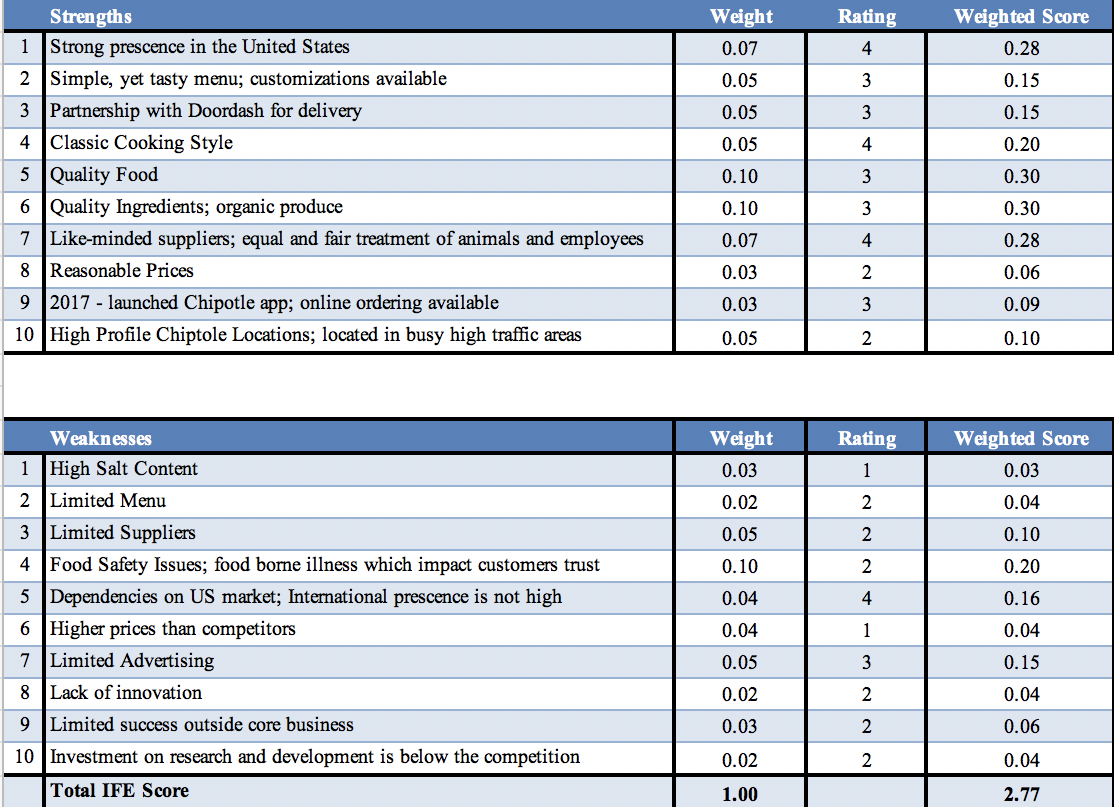
Building an IFE matrix for Chipotle Mexican Grill Inc. allowed for a detailed evaluation of the company’s strengths and weaknesses, or internal advantages and disadvantages. As seen from the first part of the matrix, one of the restaurant’s greatest strengths is its established presence on its domestic market, in the United States. The company has more than 2,400 restaurants in the US, taking up 57% of the share of limited service Mexican restaurants in the country and coming second only to Taco Bell (Lock, 2020). The second biggest strength is the restaurant chain’s integrity when it comes to sourcing raw materials: it has close ties with like-minded suppliers that are environmentally aware. Worth mentioning is Chipotle’s partnership with Doordash for delivery, which is especially relevant today amidst the COVID-19 pandemic. The restaurant owes its success to a simple, yet tasty menu with a customization menu and food made from quality ingredients.
For all its strengths, Chipotle has its own set of challenges, the biggest of which is probably its dependency on the US market and low presence on foreign markets. At the moment, outside the US, Chipotle is only present in the United Kingdom, Canada, Germany, and France, and its overseas growth is quite slow (Show, 2014). As seen from Chipotle’s 2017 annual report, the company has a limited advertising budget and low investment in research and development (Chipotle Mexican Grill, Inc., 2018). Interestingly enough, one of the company’s greatest strengths is also its significant weakness. As reported by Giamonna and Patton (2015), because the chain uses fresh food, it is more prone to spreading E.coli bacteria, which caused outbreaks in the past.
Chipotle has been delivering on its promises outlined in the “Food with Integrity” statement. However, because of the limited advertising, not all customers are aware of the company’s attempts to be more environmentally friendly and meet higher ends. For this reason, it makes sense for the restaurant chain to make consciousness front and center of its marketing campaign. Shaverien (2018) explains that today, customers’ expectations undergo significant changes: they are focusing more on conscious consumption, for which it is critical to check a company’s background and practices. As reported by Shaverien (2018), as many as 71% of young customers say that they would stop using a company’s products or services if they found out about a scandal or a controversy. Chipotle has a chance to stand out more among other restaurant companies if it appeals to customers’ endeavors to be more conscious about their consumption habits.
As for Chipotle’s weaknesses, they seem to revolve around the company’s disengagement from foreign markets. Since Chipotle is not a recognizable brand outside the United States, other countries might not be aware of its existence. For this reason, entering new markets, offering the same product might be risky. Here Chipotle might have to face another major weakness: limited menu and prices higher than their competitors. To build a presence in a new market, the restaurant chain might have to localize its production and marketing strategy, which comes at a cost. It is generally challenging to strike the right balance between pandering to foreign customers’ tastes and retaining its unique identity. Aside from that, before making such as step, Chipotle needs to work on its reputation and show the public how it tackles the food safety crisis.
References
Chipotle Mexican Grill. (2018). 2017 annual report & proxy statement. Web.
Giammona, C. & Patton, L. (2015). Chipotle’s greatest strength not it’s greatest weakness too.
Lock, S. (2020). Chipotle Mexican Grill – statistics & facts.
Shaverien, A. (2018). Consumers do care about retailers; ethics and brand purpose, Accenture research finds. Forbes.
Shaw, B. (2014). Three weaknesses for Chipotle investors to monitor in 2014.